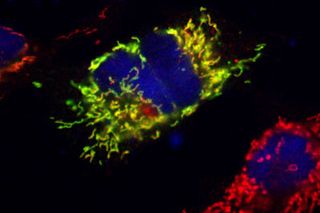Cell Suicide: An Essential Part of Life

At the cellular level, death is essential for life.
Apoptosis, sometimes called "cellular suicide," is a normal, programmed process of cellular self-destruction. Even though it involves cell death, apoptosis serves a healthy and protective role in our bodies.
The work of many researchers funded by the National Institutes of Health has taught us that apoptosis helps shape our physical features and organs before birth and rids our bodies of unneeded or potentially harmful cells. Without apoptosis, we wouldn't have distinct fingers and toes or the brain cell connections to understand the words in this article.
Apoptosis also helps support the immune system. For instance, it plays a critical role during viral infections, killing off invaded cells before they spill over with virus particles. This act of self-sacrifice hampers the spread of viruses and can save the whole organism
Cells come equipped with the instructions and instruments necessary for apoptosis. They keep these tools, called proteases, carefully tucked away like a set of sheathed knives, until some signal — either from within or outside the cell — triggers their release. This initiates a cascade of carefully coordinated events that culminate in the efficient, pain-free excision of cells.
Related: Cellular Garbage Disposals Clean Up
During apoptosis, the cell shrinks and pulls away from its neighbors. Then the surface of the cell appears to boil, with fragments breaking away and escaping like bubbles from a pot of hot water. The DNA in the cell’s nucleus condenses and breaks into evenly sized fragments. Soon the nucleus itself disintegrates, followed by the entire cell. A cellular cleanup crew made of phagocytic cells — immune cells that engulf and dispose of dead cells and debris—arrives on the scene to mop up the remains.
Sign up for the Live Science daily newsletter now
Get the world’s most fascinating discoveries delivered straight to your inbox.
A Second Way to Die
Apoptosis is one of two ways cells can die. The second, necrosis, is an unplanned response to an overwhelming stress such as a traumatic injury or exposure to poison. It's what happens to heart cells during a heart attack, cells in severely frostbitten fingers and toes, and lung cells undergoing a bout of pneumonia. While apoptosis neatly removes select cells, necrosis destroys without strategy.
Accordingly, the process of necrosis is much messier. Having lost the ability to control the flow of liquid in and out, cells experiencing necrosis swell up and eventually burst, releasing their contents into the surrounding tissue. While phagocytes still swoop in to clear the area, the chemicals involved in necrosis cause the area to become inflamed and sensitive. Think of the redness and pain in your finger after you accidentally touch a hot stove.
Life in Balance
As apoptosis destroys unwanted cells, mitosis (cell division) makes new cells. While they may seem to be at odds, apoptosis and mitosis work together to keep us healthy. For example, our skin and hair cells are renewed via a continuous cycle of apoptosis and mitosis. So are the cells lining our intestines. Because new cells replace old, worn-out ones, our tissues remain healthy.

As you can well imagine, loss of the balance between apoptosis and mitosis can have hazardous consequences. If apoptosis is triggered when it shouldn't be, our bodies squander perfectly good cells. Scientists believe that too much apoptosis is at least partly to blame for some neurodegenerative diseases, such as Alzheimer's, Parkinson's and Lou Gehrig's, and it may play a role in the fatal body-wide infection known as sepsis. On the other hand, unchecked mitosis can lead to cancer.
Learn more:
This Inside Life Science article was provided to LiveScience in cooperation with the National Institute of General Medical Sciences, part of the National Institutes of Health.
